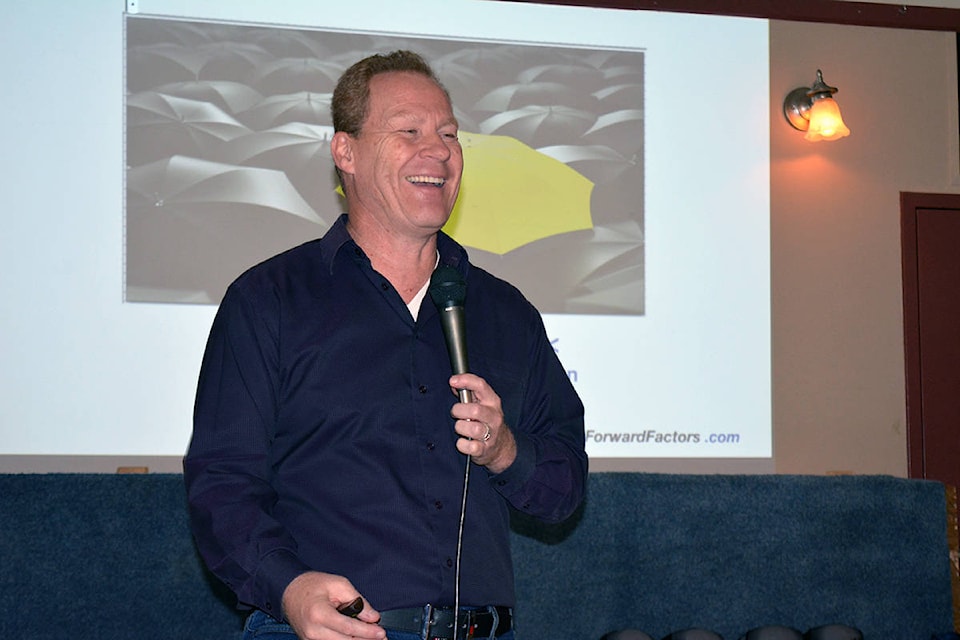By Lindsay Chung
What would our replacement do? Does what we are trying to do feed our passion and our profit? Can we compete with the best? Why are we doing this, really? Where is the opportunity in this?
These are some of the “disruptive questions” Kevin Stewart believes will help put your business in a position to innovate.
Stewart, a writer and professional speaker from southern Ontario, shared how he believes farmers and business owners can set themselves up for innovation during his presentation “The Forward Factors: Disruptive Ideas That Drive Innovation” Nov. 20 at the Vanderhoof Community Event Centre.
Stewart was in Vanderhoof as part of a Farm Credit Canada knowledge exchange event called “Disruptive Ideas That Drive Innovation and Trends and Trade Opportunities in Beef Markets.” The event also featured an update on the cattle market by Canfax Marketing manager and senior analyst Brian Perillat.
Stewart’s presentation was about the “forward factors” that drive innovation on the farm, but much of what he said could apply to any business and to life in general.
“The forward factors are disruptive, unusual ideas that cause us to innovate,” says Stewart, who learned a lot about innovation and “the growth mindset” from his father while growing up on the family farm.
Stewart says as we move into this new generation of high technology, with all the distractions technology can bring, we need to do things differently. Sharpening your focus can help.
“Growth breeds complexity,” he says. “The more we grow, the more complex the operation becomes. Complexity is the enemy of clarity. As our farm grew, we lost focus. Growth is something we’re all after. The other side of it though that we’re pursuing is technology. Technology is really cool, but it’s a bit of a problem because technology creates distraction.”
Stewart says it is important to look ahead to what is coming on the horizon and how we can take advantage of the opportunities that come with new technology and a growing population that needs to be fed.
“We can’t just keep our head down and focus on our to-do list and expect to see opportunity,” says Stewart. “We risk missing the opportunity because we are so bloody busy.”
So how do we get less busy while running a farm? Stewart says it’s a case of finding your focus.
“There is a very basic premise to all this, and this is what we used on our farm,” he says. “What you focus on grows. When you change what you focus on, you change what grows.”
Stewart says there have to be times you pause and look away from your never-ending to-do list and ask yourself what it is you want to see grow in your operation. An important question that goes along with that is “what are you focused on to make that thing grow?”
“This was the big game-changer for us on the farm: are you focused on growth or comfort?” he says.
The next forward factor that is so important is quitting the things, people or ideas that take our energy and focus away from what is really important to us, according to Stewart.
“Doing less helps us to focus on what our core beliefs are,” he says. “Quitting is a really important factor to finding our sweet spot. Various research finds we spend less than 20 per cent of our day in our sweet spot, that area of the business where it doesn’t feel like work and business is just humming along.”
Stewart says it can be hard to decide what to quit, but he uses the analogy of picking stones in the field, something he learned from his father.
“Dad said ‘the thing with picking stones is you always pick the big stones first,’” he says. “The premise I didn’t realize Dad was putting in place was the importance of doing first things first. So many of us miss innovation because we do the second things first. I want you to do what is important to you first.”
Stewart says the “big stones” in your business and your life are the things that you could not live without. Stewart made a list of his five big stones, and every time he gets a request, he will only add it to his to-do list if it fits into his five big stones.
Another of Stewart’s forward factors is a concept called “risking forward.”
“On our farm, when in doubt, do something,” he says. “I was raised, in the beginning anyways, when in doubt, you pause and wait, but there are times you need to be light and fast and risk forward. It is not about taking crazy risks. It is a calculated risk, and the reason it works is you are in continual action.”
Stewart says failure is the drawback of risking forward, but you have to be OK with failure.
“Dad told me you have to understand that failure is nothing more than information, and the faster you do it, the more information you get,” he says.
Stewart says another forward factor that puts us in a position to innovate is our network. In fact, he says, our network is the single greatest predictor of success in business.
“The people you surround yourself is a powerful force in how your life turns out,” he says.
newsroom@ominecaexpress.com
Like us on Facebook and follow us on Twitter
